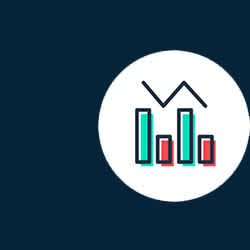
March 28, 2022
Understanding the Post-Covid Indicator
Understanding the Post-Covid Indicator
Flexport’s Post-Covid Indicator was launched in June 2021 to track the balance between consumer spending on goods and services. Increased spending on goods has been a major driver of logistics network activity. We have now released extensions to the PCI including a split between durable and nondurable goods as well as adjusting for price inflation. Our revised measures find that consumer preferences on both goods types versus services in both real and nominal terms is set to remain elevated above pre-pandemic levels into Q2’22, though inflation adjusted preferences for nondurable goods may be sliding.
Pandemic Drives Major Spending Shift
A key economic characteristic of the pandemic in the United States has been a shift in consumer spending away from services and towards goods. That came initially as lockdowns cut the opportunity for spending on travel, food, arts and entertainment among others.

As indicated in Figure 1 above, the split of consumer spending remained fairly constant ahead of the pandemic shock. The initial lockdowns led to a slump in spending on services with the result that the goods share-which averaged 31.3% of the total in the four years running up to the pandemic-increased mechanically.

In a second stage spending on goods for the home boomed, supported by government income support. Given U.S. consumer goods spending relies heavily on imports, it’s perhaps not surprising to see goods spending and merchandise imports increased closely, as shown in Figure 2 above. Note the data is dominated in seasonally adjusted and in nominal (i.e. not inflation adjusted) terms.
Elevated consumer spending has also dragged on retail inventories as firms have struggled to keep up with demand. Indeed, the gap between the green and red lines in Figure 2 can be seen as a run-down in inventories. Yet, as discussed in recent Flexport research, the level of retail inventories has started to recover.
The direction of future consumer spending on goods versus services is therefore a matter of significance for manufacturers, retailers, and of course the logistics firms that join them together.
The PCI Methodology and Interpretation
The question that arises is: where might consumer spending preferences go next?
The Flexport Post-Covid Indicator, first launched in June 2021, is designed to provide an indication of where consumer spending preferences may be over the next few months.
The PCI is based on an analysis of correlations between detailed shipping data and national consumption behavior. The latter is defined by U.S. Bureau of Economic Analysis data, which is typically published four- to five weeks in arrears for a given month (e.g. February 2022 data is published on March 31).
As one would expect, given how goods move, the closest correlations are between shipping flows in a month and consumption a bit later. Using the estimated model, we are able to look at more recent shipping data and forecast the consumption patterns that are likely to follow.
The PCI is updated on a monthly basis alongside Flexport’s other major indicators for trade activity, air- and ocean freight timeliness, supply chain costs and logistics pressure measures.

The PCI is constructed such that readings near zero signal a return to pre-COVID norms—based on data in the four years leading to the COVID shock—in consumer spending preferences. Readings around 100 signal a continued deviation from pre-COVID norms inline with spending patterns seen from June to September 2020.
As shown in Figure 3 above the preference for goods over services is expected to continue at around 120-130 through April 2022. That would suggest little let-up in demand for shipping services if the level of consumer spending remains high in absolute terms.
Durable vs. Nondurable Goods
The next question is whether the same pattern applies to all types of goods?
A notable feature of pandemic-era spending has been an emphasis on spending on durable goods vs. nondurable goods. We have therefore launched alternative “flavors” of the PCI to differentiate the outlook for durable and nondurable goods, as shown in Figure 4.

Durables include products that typically are replaced no more than once every three years, for example home appliances, furniture, consumer electronics and fitness equipment. The stay-at-home period led many households to prioritize spending on making living conditions more comfortable.
Nondurable products meanwhile are replaced more often and include clothing, household and personal care products, food and beverages. Demand for HPC products boomed early in the pandemic while spending on clothing was moderated.
Figure 4 shows that demand for both durable and nondurable goods versus services will likely remain elevated versus pre-pandemic levels through April 2022. On a relative basis spending is expected to remain biased toward durable goods at levels seen in the first half of 2021. The preference for nondurable goods meanwhile is expected to dip slightly below summer 2020 levels.
Inflation Matters
If demand is elevated but supply chains are constrained, does pricing matter?
The impact of inflation on reported trade statistics has been an ongoing preoccupation for Flexport Research. Starting with trade- and supply chain costs in 2021 and crystallized as elevated consumer prices in 2022, higher inflation has boosted both the value of goods versus services consumption and the growth rates associated with spending and trade activity.
We have therefore generated new versions of the PCI which show both nominal and real (adjusted for inflation) levels. There is a challenge in this as the price deflators of durable goods, nondurable goods, and services have not remained in sync. We have made the appropriate adjustments in each case,

As shown in Figure 5, stripping out the effect of price inflation makes a marked difference to the calculations. That reflects goods price inflation having outstripped that for services during the pandemic period.
The dotted green line in Figure 5 shows that durable goods demand relative to services adjusted for inflation is close to summer 2020 levels.
The dotted red line meanwhile shows that demand for nondurable goods relative to services is around one third (i.e. a reading of 67 in April 2022) of the way back from those summer 2020 levels to the pre-pandemic norm when adjusting for inflation.
In conclusion: U.S. consumer spending habits remain biased further towards goods than they have been historically, though when adjusting for inflation and goods type they are either in-line with or already slightly below summer 2020 levels. That may act as a drag on logistics activity, particularly on TPEB routes, as demand particular for consumer durable goods including furniture and leisure products, begins to decline.
Disclaimer: The contents of this report are made available for informational purposes only and should not be relied upon for any legal, business, or financial decisions. Flexport does not guarantee, represent, or warrant any of the contents of this report because they are based on our current beliefs, expectations, and assumptions, about which there can be no assurance due to various anticipated and unanticipated events that may occur. This report has been prepared to the best of our knowledge and research; however, the information presented herein may not reflect the most current regulatory or industry developments. Neither Flexport nor its advisors or affiliates shall be liable for any losses that arise in any way due to the reliance on the contents contained in this report.






